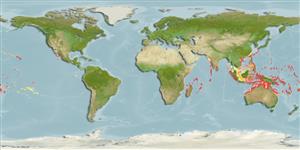Common names from other countries
Environment: milieu / climate zone / depth range / distribution range
Ecologia
marinhas associadas(os) a recifes; intervalo de profundidade 0 - 50 m (Ref. 90102). Tropical; 30°N - 25°S
Indo-Pacific: Maldives to the Tuamoto Islands, north to Ryukyu Islands, south to the Great Barrier Reef.
Tamanho / Peso / Idade
Maturity: Lm ? range ? - ? cm
Max length : 26.0 cm TL macho/indeterminado; (Ref. 9710)
Espinhos dorsais (total) : 13 - 14; Raios dorsais (total) : 23 - 26; Espinhos anais: 3; Raios anais : 19 - 22. The abdominal region of females is noticeably thick set. Body is golden yellow; base of the posterior portions of the dorsal and anal fins black; a prominent vertical black bar running across the eye; diagonal rows of black dots on the sides. A filament originating from the soft portions of the dorsal fin rays trails posteriorly (Ref. 4855). Snout length 2.4-2.9 in HL. Body depth 1.6-1.9 in SL (Ref. 90102).
Uncommon species (Ref. 9710) found in coral rich areas of clear water lagoon and semi-protected seaward reefs. Usually in pairs or small groups, more wary than most species. Minimum depth reported taken from Ref. 30874. Oviparous (Ref. 205). Minimum depth reported taken from Ref. 128797.
Ciclo de vida ou comportamento de acasalamento
Maturities | Reprodução | Spawnings | Egg(s) | Fecundities | Larvas
Distinct pairing (Ref. 205).
Myers, R.F., 1991. Micronesian reef fishes. Second Ed. Coral Graphics, Barrigada, Guam. 298 p. (Ref. 1602)
Status na Lista Vermelha da UICN (Ref. 130435)
CITES (Ref. 128078)
Not Evaluated
Ameaça para os humanos
Harmless
Uso pelos humanos
Pescarias: pouco comercial; Aquário: Espécies comerciais
Ferramentas
Relatórios especiais
Baixar XML
Fontes da internet
Estimates based on models
Preferred temperature (Ref.
115969): 24.9 - 28.9, mean 27.7 (based on 646 cells).
Índice de diversidade filogenética (Ref.
82804): PD
50 = 0.5000 [Uniqueness, from 0.5 = low to 2.0 = high].
Bayesian length-weight: a=0.02291 (0.01133 - 0.04632), b=3.00 (2.83 - 3.17), in cm Total Length, based on LWR estimates for this Genus-body shape (Ref.
93245).
Nível Trófico (Ref.
69278): 2.7 ±0.25 se; based on food items.
Resiliência (Ref.
120179): Elevada, tempo mínimo de duplicação da população menor que 15 meses (Preliminary K or Fecundity.).
Fishing Vulnerability (Ref.
59153): Low vulnerability (16 of 100).
